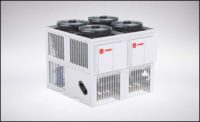Yang Han landed in exactly the right place at The Ohio State University to begin a career in decarbonizing flue gas from fossil fuel-burning power plants.
After obtaining his Ohio State doctorate degree in chemical engineering in 2018, Han is now a research scientist working with distinguished professor of engineering Winston Ho, who, for more than 20 years, has developed methods to reduce fossil fuel-generated pollution during a career at Exxon and on the faculty at Ohio State. Ho, a professor of both chemical and biomolecular engineering and materials science and engineering, developed a membrane that can cost-effectively capture 90% of the CO2 emitted from coal-fired power plants.
Now, Ho and Han have received $4 million in U.S. Department of Energy (DOE) National Energy Technology Laboratory funding to expand that transformational carbon dioxide capturing process beyond the lab to the next step toward commercialization.
DOE has supported Ho’s work with more than $12 million since 2012. The most recent funding will enable expansion of this research to a project 18 times the size of current bench-scale laboratory work, where he has proven that the purity of that captured CO2 is at least 95%, important because demand for quality CO2 is growing in the oil, chemical, and food industries.
Han became interested in the research because of growing up in a coal mine town.
“My hometown of Shanxi, China, has a climate very similar to Columbus,” Han said. “We have many coal-fired plants there. In the wintertime in China, for residential areas we do not have furnaces in every household. We have centralized heating, where you take cooling water from power plants that is 80°C and circulate that water throughout the city. That residual heat keeps your home warm. The downside is the pollution issues you always have from the coal powder — the air pollution is very severe.
“I want to spend my career to invest in this area to further the technology and to hopefully have the technology not only in the U.S. but worldwide, so we can reduce the CO2 emissions globally,” Han continued.
The technology relies on a chemical reaction: The membrane is a polymer matrix with a chemical quality that can react to, capture, and release CO2.
Most significantly, the process meets DOE’s goal of developing a carbon capture technology that costs less than $40 per metric ton.
“We may have the only technology that can meet the DOE target,” Ho said. “We are the only one they have asked for the engineering-scale project.”
At the engineering scale, Ho and Han will work to prove that the membrane technology can be expanded for use with the production of 1 MW of energy, capturing 20 tons of CO2 a day. To give that some perspective, Ohio State’s current power plant is about 10 MW — the size at which they expect to be able to design the membrane process about halfway through this four-year project. To continually receive funding for this work, they need to prove the technology works at progressively larger scales.
When the project expands to the demonstration scale of 100 MW, it could be applied to a small commercial power plant.
“We are still maybe another five to six years away from commercial-size demonstration plant,” Ho said.
The $4 million DOE funding is part of a $13 million grant to construct a membrane skid, or test unit, that can be integrated into a power plant. Ohio State will fabricate the membrane and the modules into which the membrane is spiral-wound and then used to capture carbon dioxide from the flue gas, and the remaining funding will go to the other partners of the project team for the construction and testing of the skid.
Other partners and their roles:
- Gas Technology Institute (GTI), in Des Plaines, Illinois, will design the test unit based on Ohio State’s transformational membrane process.
- A membrane test skid construction company yet to be determined will build the membrane test unit.
- Wyoming Integrated Test Center (ITC) in Cheyenne will integrate the unit into a power generating system.
- “ITC is operating as a power plant,” Han explained. “Essentially we need the skid — all the components of the operating system. The project team ships it to ITC and hooks into their flue gas line so we can demonstrate how to capture carbon dioxide from the actual flue gas.”
- Ohio State and GTI will participate in conducting tests on coal flue gas at ITC to demonstrate a continuous, steady-state operation for a minimum of two months and gather data for further process scale-up.
- Trimeric Corp., Buda, Texas, will conduct an independent economic evaluation of the cost for the CO2 capture.
Ho added that work on developing the membrane is not finished.
“We are still making progress toward a better membrane for reducing the CO2 capture cost — even after doing the work for this $4 million, we already have a better membrane in our laboratory,” Ho said. “Research is a continuous effort for continuous improvement.”
This article appears courtesy of the Sustainability Institute at Ohio State University. See the article in its entirety at https://si.osu.edu/news/capturing-carbon-fossil-fuel-energy-ohio-state-membrane-technology-moves-closer.





